Abstract
This study aims to investigate a new shear reinforcement method which utilizes thin mild steel (TMS) plates as shear reinforcement in deep beams to replace conventional reinforcement. Thirteen reinforced concrete deep beam specimens with three different plate thicknesses and four varying perforated hole arrangements on the TMS plates were experimentally tested to determine the load-carrying capacity and crack pattern. The experimental results indicate that the 2.0 mm thick TMS plate has the highest load-carrying capacity. Among the four different hole arrangements on the TMS plates, the perforated plates with a three-column hole arrangement show the best performance in terms of load-carrying capacity, with a 2.9% increment against the control beam specimen. The specimens also demonstrated compatible elastic stiffness with the control beam that used conventional shear links. This shows that TMS plates have the potential to replace conventional shear links in deep beams. This proposed method also changed the failure mode from conventional diagonal shear tension failure to a combination of flexural failure and shear deformation. A numerical model was developed and was found to have a good correlation with the experimental results, demonstrating potential for use in future parametric investigations on deep beams and cost reduction in future experimental work.
1. Introduction
Reinforced concrete (RC) beams are horizontal structural members designed to transfer loads from floor slabs to columns. Deep beams are introduced when long-span horizontal members are subjected to highly concentrated loads. According to EN1992-1-1:2004 [1], a deep beam is a beam with a span-to-depth ratio of less than 3. A greater lever arm as a result of the increased beam depth offers higher flexural resistance, but makes deep beams more susceptible to shear failure. Hence, shear reinforcement must be adequately provided to prevent brittle failure [2].
Many studies have focused on the use of alternative materials as shear reinforcement in concrete beams. One of the most popular materials used as shear reinforcement in beam strengthening and repair works is fiber-reinforced polymer [2,3,4]. This material has been shown to effectively increase beam capacity, although it does not improve the ductility of the structural element [5]. Furthermore, one of the drawbacks of the use of this material as an external retrofit is the high quality and skilled workmanship required in the preparation of the surface or groove for the bonding of the fiber-reinforced polymer sheet with the beam, proper attachment of the mortar, and curing.
Other than fiber-reinforced polymer, the application of steel plates as shear reinforcement has been examined by several researchers. Steel plates are easily available and can be retrofitted to the exterior faces of conventional RC beams easily, with minimal interference to the overall size of the structural element. Adhikary and Mutsuyoshi [6] examined the structural performance of steel plates attached externally to both sides of the concrete beam using epoxy and bolts. They suggested that shear contribution was maximized when the steel plate was placed at the maximum possible section depth instead of increasing the thickness of the steel plate. Sudarsana et al. [7] proposed bolting a piece of U-shaped steel plate and two pieces of L-shaped steel plates as shear reinforcement within the shear span. This study pointed out that insufficient plate thickness might lead to out-of-plane warping when the beam was subjected to high loads. Furthermore, they pointed out that thin steel plates were unable to sustain concentrated transverse load at the bolt hole, which led to local failure. Arslan et al. [8] attached external steel plates to the sides and soffits of beams using epoxy resin. Five out of six of the specimens demonstrated premature failure due to shear when the steel plates “peeled off” from the beams. These two common methods of attaching steel plates externally to concrete beams as additional shear reinforcement by bolting or by bonding with epoxy resin demonstrated the premature failure of steel plates. Insufficient plate thickness resulted in premature local failure at bolt holes, while excessive plate thickness resulted in delamination of the plate. The above literature shows that, whilst the use of steel plates as an external retrofit is a viable option for deep beams in the service stage, the premature failure of external plates must be addressed. Adopting suggestions from these studies, other researchers embedded steel plates or steel sections into beams prior to casting to resolve the detachment, warping, and local failure occurrences in the external steel retrofitting method. Hou et al. [9] studied the effects of embedding single and double steel plates in coupling beams with a span-to-depth ratio of 2.5. Shear studs were used to improve bonding between the plate(s) and concrete. The results showed the occurrence of flexural failure in the specimens. Chen et al. [10] and Deng et al. [11] investigated the effects of embedding steel I-sections in deep beams. Neither shear studs nor any special configuration was included in their study to promote composite action between the I-sections and the concrete. They concluded that embedding steel I-sections with wider flanges or deeper webs in deep beams could compromise the quality of casting and compaction work, particularly in the beam-to-column joint zone, which has complicated detailing. Wang et al. [12] found that specimens with interval holes in the web of concrete-encased steel sections could yield higher ultimate shear resistance and shear stiffness due to the composite action between the I-section and the concrete. Hence, these studies show that adequate bonding between embedded steel section in concrete beams is critical and bonding can be achieved by installing shear studs or by incorporating perforated holes into the webs of steel sections.
In conventional reinforced concrete beams, shear reinforcement is provided by shear links to resist shear forces. Existing research has demonstrated various methods of providing shear reinforcement, with recent research exploring the introduction of materials such as fiber-reinforced polymer or steel plates to complement conventional shear links. However, the potential to use embedded thin steel plates with perforated holes to replace conventional shear links inside RC deep beams is yet to be addressed. Hence, this study aims to investigate the performance of an alternative shear reinforcing method by fully replacing conventional shear links with perforated thin mild steel (TMS) plates in RC deep beams. Thirteen deep beam specimens were prepared with two variables, namely (i) perforated hole configurations of zero, three, four, and five columns of holes in the TMS plates and (ii) TMS plate thicknesses of 1.5, 2.0, and 2.5 mm.
2. Materials and Methods
2.1. Reinforcement Design
The analytic strut and tie model (STM) follows the model described by Foster [13], where the type of STM is determined based on the ratio of shear span a to internal lever arm, z as follows:
Type I: a/z ≤ 1;
Type II: 1 < a/z < √3;
Type III: a/z ≥ √3.
According to Foster [13], the specimens in this study were categorized as Type II. Therefore, the shear forces are carried by the major and minor compressive struts. Figure 1 shows the Type II STM of the specimen. The vertical component of the force carried by the tie is represented by Tw. The total vertical component of the external load carried through the shear span is represented by V. The ratio of a/z affecting the ratio between Tw and F is expressed in Equation (1). Hanger reinforcement is provided to transfer Tw to the top of the member in this Type II model. The internal force in each component was then determined. All reinforcements required were determined based on Tw. The reinforcement required for the control specimen, FP series specimens, and HP series specimens were designed based on Equation (2), Equation (3), and Equation (4), respectively.
in which
a = 300 mm;
z = 209 mm.
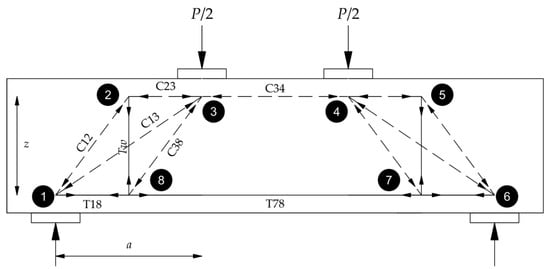
Figure 1.
Layout of STM.
2.2. Specimen Description
Thirteen RC deep beam specimens comprising one control specimen and twelve specimens were fabricated in this study. The specimens had a shear span-to-depth ratio of 1.09 and were 1100 mm in length × 150 mm in width × 275 mm in depth. Longitudinal bars of 2T10 and 2T12 were installed at the top and bottom of the specimens, respectively. A 30 mm thick concrete cover was adopted in this study for all the specimens. Figure 2 shows sectional views and the reinforcement detail of all thirteen specimens.
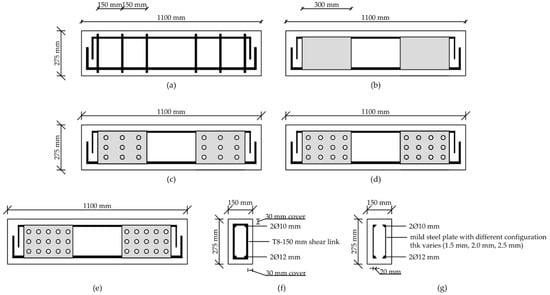
Figure 2.
Reinforcement detailing of specimens. (a) specimen CS; (b) FP series; (c) HP3 series; (d) HP4 series; (e) HP5 series; (f) section view of specimen CS; (g) section view of FP and HP series.
Shear reinforcement of T8 at 150 mm spacing was installed in the control specimen, as illustrated in Figure 2a,f. The control specimen was labelled specimen CS.
The remaining twelve specimens were fabricated with TMS plates as shear reinforcement. The plates were provided at each side of the specimen within the shear span, as illustrated in Figure 2b,e. The top and bottom ends of the TMS plates were bent with a 20 mm fold and tied to the longitudinal bars using galvanized iron wire, as shown in Figure 2g. Specimens with TMS plates were classified into four series, based on the number of columns of holes made on the TMS, namely (a) full plates without holes, (b) plates with three columns of holes, (c) plates with four columns of holes, and (d) plates with five columns of holes. In the horizontal direction, all the holes were arranged in three rows on the TMS plate. Holes with a 25 mm diameter were adopted to allow aggregates to pass through the plates, thus enabling bonding between the concrete matrix and TMS plates. Moreover, three plate thicknesses of 1.5 mm, 2.0 mm, and 2.5 mm, were adopted in this study. Figure 3 shows the detailed configuration of the TMS plates for each series. Table 1 shows the designated names of all the specimens. The specimens were designated by the number of columns in the hole arrangements on the TMS plates, followed by the plate thickness.
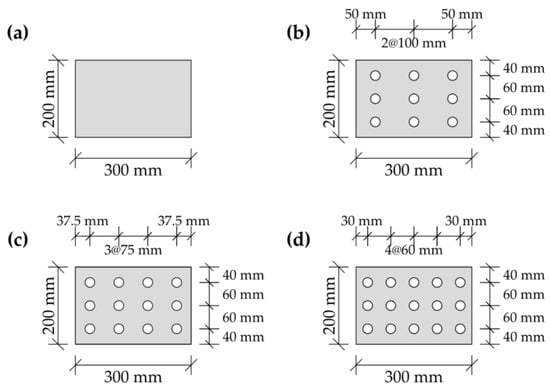
Figure 3.
Configuration of TMS plates. (a) FP series, (b) HP3 series, (c) HP4 series, (d) HP5 series.

Table 1.
Designated names of specimens.
All the specimens were cast with Grade 20 cube strength premixed concrete. The concrete cubes and cylinders were cast and tested in accordance with BS EN 12390-3 [14] and BS EN 12390-6 [15], respectively. Based on the average value of the three specimens, the 28-day concrete compressive strength and splitting tensile strength were 21.56 MPa and 2.04 MPa, respectively. Tensile testing in accordance with ISO-6892-1 [16] was performed on all the steel bars and TMS plates. Table 2 and Table 3 summarize the mechanical properties of the high tensile steel bars and TMS plates, respectively.

Table 2.
Mechanical properties of high tensile steel reinforcement bars.

Table 3.
Mechanical properties of TMS plates.
2.3. Testing Setup
A four-point loading test was adopted for this study. A Magnus Test Frame with a maximum capacity of 300 kN was used to study the performance of the thirteen specimens. The specimens were preloaded to ensure that the instrument was functioning properly and to avoid any poor contact [17]. The specimens were loaded monotonically under displacement control at a loading rate of 0.01 mm/s [18]. The load was applied to the specimen through two loading steel plates at the top of each specimen [18]. The center-to-center distance between the two loading plates was set at 300 mm. All the specimens were simply supported by two bearing plates at the reaction base, with a clear span of 800 mm. Steel roller supports were placed at the soffits of both reaction bases to provide hinged support for the specimens. Three units of linear variable differential transducer (LVDT) were installed at the bottom of each specimen to measure the vertical displacement during the testing at L1, L2 and L3 positions. The typical setup of the deep beam testing is illustrated in Figure 4. All the LVDTs were connected to a data logger for displacement data collection throughout the entire testing program. White paint was applied to the surface of the specimens and 50 mm × 50 mm grids were drawn on the front of each specimen to trace and map surface concrete cracking patterns. The test was terminated once the specimen showed significant deflection and failed to resist additional load.

Figure 4.
Four-point loads testing setup.
3. Experimental Results and Discussion
The experimental results of the tested specimens are discussed in terms of their load-carrying capacity, load-displacement behavior, cracking pattern, and failure mode. Comparisons are made between specimen CS and specimens with TMS plates.
3.1. Load-Carrying Capacity
Table 4 shows the attained ultimate load, percentage of load difference against specimen CS, and mid-span deflection in all the specimens. The attained ultimate loads for all the specimens are compared in Figure 5. The ultimate load capacity of specimen CS is 240 kN. It is highlighted in a red dashed line in Figure 5.

Table 4.
Experimental results of ultimate load and deflection.
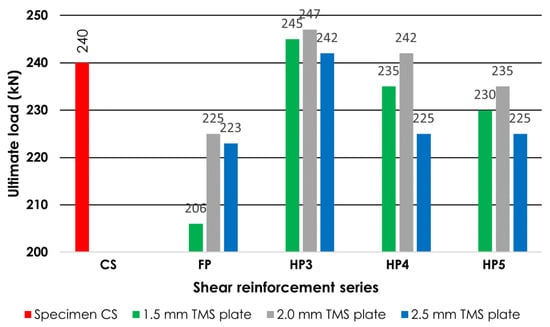
Figure 5.
Ultimate load for each specimen.
3.1.1. Effect of Perforated Hole Arrangement
The FP series specimens attained an ultimate load capacity ranging from 206 kN to 225 kN, which is 6.3% to 14.2% lower than specimen CS. The adoption of TMS plates without any holes appears to create a substantial area of partition effect that separates the side concrete cover from the core of the beam [19]. As a result, the FP series specimens had a much lower ultimate load capacity than specimen CS and the HP series specimens.
For the HP series specimens, the attained ultimate load-carrying capacity ranged from 225 kN to 247 kN, recording −6.3% to +2.9% differences compared with specimen CS, but demonstrating a higher ultimate load attainment than the FP series specimens. This phenomenon was also noticed by Wang et al. [12] in their study, in which concrete-encased steel sections with holes in the web attained a higher shear capacity than the specimen without any holes in the web. The presence of perforated holes in the HP series encouraged the concrete matrix passing through the plate, allowing the formation of tenons enabling a better force transfer from the concrete to the steel plates [20]. Furthermore, the formation of tenons acted as concrete dowels that delayed slippage and debonding of the steel plate–concrete interface.
When comparing the HP series specimens (HP3, HP4, and HP5), the HP3 series specimens showed a slightly higher ultimate load attainment than the other two series specimens. In particular, the HP3-2.0 specimen attained an ultimate load of 247 kN, which is 2.1% and 5.1% higher than the HP4-2.0 and HP5-2.0 specimens, respectively. When the number of columns of holes increased from three to five, the ultimate load decreased, regardless of the thickness of the TMS plate being used. This indicates that introducing more columns of holes into the TMS plate adversely affects the stiffness of the plate [21] and reduces the benefit contributed by concrete tenon formation to the overall load-carrying capacity. This is due to the compressive strut in the deep beam having passed through the TMS plate with a greater unreinforced area due to closely spaced holes in the TMS plate.
3.1.2. Effect of TMS Plate Thickness
When comparing the specimens with different plate thicknesses but similar perforated hole arrangements, the specimens with a plate thickness of 2.0 mm showed a higher load-carrying capacity than those of 1.5 mm and 2.5 mm plate thickness. This may be due to insufficient stiffness in the 1.5 mm thick plate to withstand the shear force induced in the specimens. Plates with 2.5 mm thickness are too stiff, resulting in a large difference between the relative stiffnesses of the concrete and plate. This reinforces the finding by Adhikary and Mutsuyoshi [6]. Thus, internal force initially resisted by the concrete may not be transferred effectively to the steel plate, causing a lower ultimate load attainment in the specimens with 2.5 mm thick TMS plates.
3.2. Load-Displacement Behaviour
The load versus mid-span displacement curve for each specimen is presented in Figure 6 and the magnitude of deflection at ultimate load is presented in Table 4. Specimen CS recorded a deflection of 7.27 mm upon reaching an ultimate load of 240 kN.
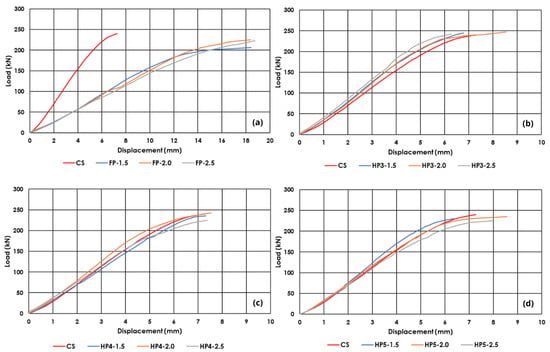
Figure 6.
Load versus mid-span deflection curve. (a) Specimen CS and FP series, (b) Specimen CS and HP3 series, (c) Specimen CS and HP4 series, (d) Specimen CS and HP5 series.
3.2.1. Effect of Perforated Hole Arrangement
The FP series specimens show a high mid-span deflection with values ranging from 18.39 mm to 18.77 mm. These values are approximately 2.5 times greater than the 7.27 mm deflection recorded by specimen CS. Figure 6a shows that the FP series specimens have less stiff load-displacement curves compared with that of specimen CS. This is attributed to the inability of the TMS plate without holes in the FP series specimens to achieve sufficient bonding with the concrete matrix. As a result, delamination of the side concrete cover from the concrete core was observed in the FP series specimens before the applied load reached the ultimate load capacity stage.
Apart from the FP series specimens, all the HP series specimens yielded similar load-displacement curves as specimen CS. This shows that the presence of perforated holes in the TMS plates could prevent delamination of the side concrete cover, hence ensuring the integrity of the concrete beam.
3.2.2. Effect of TMS Plate Thickness
Specimens with plate thicknesses of 1.5 mm, 2.0 mm, and 2.5 mm were plotted graphically in blue, orange, and grey, respectively, in Figure 6. Of the nine specimens from the HP series with perforated TMS plates as shear reinforcement, the specimens with a perforated plate thickness of 2.0 mm attained the largest displacement before failure when compared with specimens of other plate thicknesses, as observed in Figure 6b–d [22].
3.3. Crack Pattern and Failure Mode
Figure 7 shows the crack development of each specimen traced continuously throughout the four-point load test until ultimate capacity was reached. Three types of failure mode were observed in the thirteen specimens as follows: Type 1: Specimen CS showed pure shear failure dominated by diagonal tension failure; Type 2: All three of the FP series specimens showed flexural failure followed by sudden diagonal tension cracking; and Type 3: All nine of the HP series specimens showed flexural failure followed by gradual diagonal tension cracking. Figure 8 summarizes these three types of crack development.
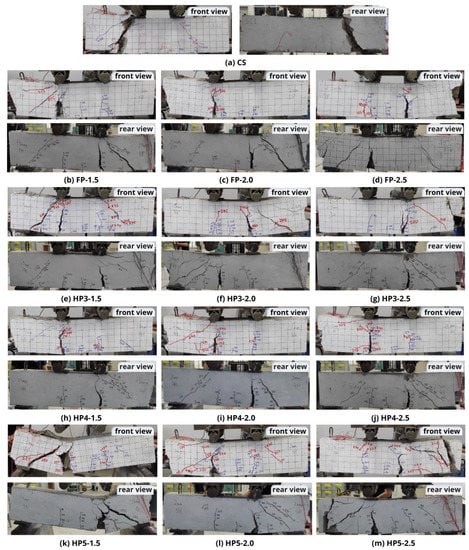
Figure 7.
Crack development of specimens.
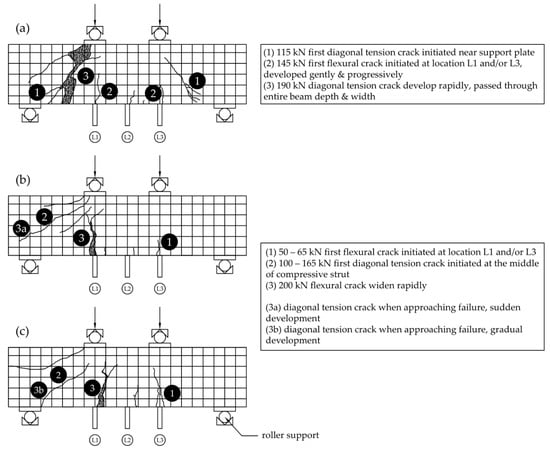
Figure 8.
Development of cracking. (a) Specimen CS (b) FP series specimens (c) HP series specimens.
For specimen CS, the first crack was initiated by a diagonal tension crack that occurred near the support plate when a load of 115 kN was reached. The diagonal tension crack propagated diagonally upwards towards the loading plate as the load was increased incrementally to 165 kN. At a loading of 145 kN, the first flexural cracks were observed at locations L1 and L3 where the LVDTs were installed, developing slowly as the loading was increased. After a loading of 190 kN was reached, the diagonal tension cracks propagated rapidly. Upon reaching the failure load, the cracks passed through the entire depth and width of the beam. Diagonal tension failure was observed when an ultimate load of 240 kN was reached.
3.3.1. Early Stage and Intermediate Stage of FP and HP Series Specimens
Both the FP series and HP series specimens showed similar crack patterns at the early and intermediate stages of loading but exhibited different failure modes towards the late stage of loading. At the early stage of loading, the first flexural crack in both series was observed at L1, L2, and/or L3 locations when loads ranging from 50 kN to 65 kN were applied. As the loads were increased incrementally from 100 kN to 165 kN, the first diagonal tension cracks were observed at the center of the compressive strut within the shear span. These flexural cracks were observed to widen rapidly when both series were loaded beyond 200 kN. As the specimens moved towards failure, differences in the progression of the diagonal tension crack development were observed in the FP and HP series. The diagonal tension cracks in the FP series specimens developed rapidly whilst the diagonal tension cracks in the HP series specimens developed gradually.
3.3.2. Late Stage of FP Series Specimens
In contrast to the ribbed high tensile bar in specimen CS, the TMS plates without any holes in the FP series specimens have smooth and flat surfaces on both sides. This barely enabled the plates to form an adequate bonding with the concrete. This prevented the transfer of shear forces from the concrete to the TMS plate in the FP series specimens when loaded and resulted in the development of sudden diagonal tension cracks in the FP series specimens upon reaching failure load.
3.3.3. Late Stage of HP Series Specimens
The fabricated holes in the TMS plates in the HP series specimens enabled the formation of concrete tenons in the holes, improving the bonding between the concrete matrix and the plates. This promoted a better force transfer from the concrete to the TMS plates, including diagonal tensile force transfer. The HP series specimens were observed to have a more gradual development of diagonal tension cracks when approaching the later stage of the loading when compared with the HP series specimens.
3.3.4. Effect of Adopting TMS Plates on the Failure Mode
The implementation of TMS plates to replace conventional shear links in deep beams altered the failure mode, shifting it from predominantly shear diagonal tension failure to a combination of flexural failure and shear deformation. Despite reinforcing bars having a higher yield strength than TMS plates, substituting the former with the latter as shear reinforcement could provide an overall greater amount of bidirectional shear reinforcement [23]. This bi-directional property can significantly increase shear capacity without raising any steel congestion issues that unidirectional shear links would raise. Nonetheless, the main concern in beams using TMS plates as shear reinforcement is the adequacy of the bonding to prevent slippage between the TMS plates and longitudinal bars [20]. This is addressed by fabricating different number of holes in the TMS plates, ensuring a gradual progression in diagonal tension failure in the HP series specimens.
4. Numerical Analysis
4.1. Numerical Modelling
ABAQUS nonlinear finite element software was used to simulate all the experimentally tested specimens. Figure 9 shows the testing setup of the numerical models as conducted in the experimental program. In this simulation, only a quarter of the specimens were modelled by considering the symmetry configuration of the specimen length and width. This modelling technique can reduce computation time [24] without compromising the validation of the numerical results for a full model.
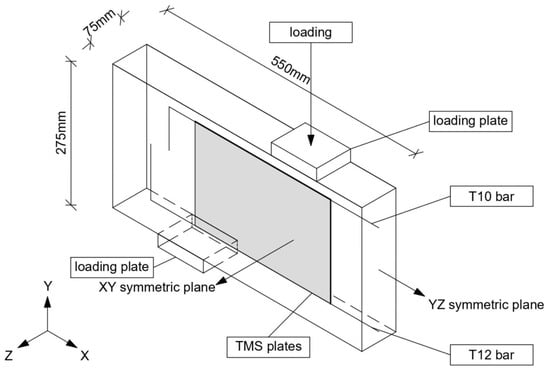
Figure 9.
Numerical model assembly.
The numerical models adopted concrete damage plasticity (CDP) model for the concrete material. Table 5 summarizes the concrete damage plasticity parameters. The concrete beam was modelled in C3D8R elements (8-node linear bricks with reduced integration). The concrete compression damage behavior parameters, which are compressive stress (), and the corresponding inelastic strain (), were derived from Carreira and Chu [25]. The concrete compression damage parameter () and concrete tension damage parameter () were derived from Lima et al. [26]. The tensile stress () and corresponding inelastic strain () were derived from the Modified Tension Stiffening Model [27]. The density and Poisson’s ratio of concrete were adopted as 2500 kg/m3 and 0.2, respectively. The cube compressive strength of concrete of 21.56 MPa adopted in the model was based on experimental testing at 28 days age, . The elasticity modulus of concrete was 26,245 MPa based on the formula suggested by Pauw [28].

Table 5.
Concrete damage plasticity parameters.
The high yield deformed steel bar was modelled in T3D2 (2-mode linear 3-D truss) whereas the mild steel plate and loading plate at support were modelled in C3D8R elements (8-node linear bricks with reduced integration). The stress–strain relation of both the high yield deformed steel bar and the mild steel plate were modelled in an elastic-perfectly plastic model with a gentle slope, as adopted by Abdel-Nasser et al. [29]. Table 6 summarizes the properties of the steel reinforcement used in the numerical simulation work.

Table 6.
Steel reinforcement properties.
The interaction between the concrete beam and high yield steel bar was modelled as an embedded region to reflect the non-slip reinforcement condition. Meanwhile, the interaction between the concrete beam and mild steel plate was modelled as surface-based cohesive behaviour. The traction-separation behaviour was selected with stiffness coefficients in normal and two tangential directions, , , and , as 65 MPa/mm, 5 MPa/mm, and 5 MPa/mm, respectively [12]. The maximum separations at damage initiation in the normal and two tangential directions, , , and were taken as 0.025 mm, 0.06 mm, and 0.06 mm, respectively [12]. Damage evolution was employed along with a linear softening law where the total displacement at failure was adopted as 2.5 mm [12].
The element shape of the concrete beam was assigned as tetrahedral, whereas the mild steel plate and loading plate were assigned as hexahedral and meshed with a mesh size of 25 mm. The high yield steel bars were assigned as truss elements with a mesh size of 25 mm. Two-point loads were gradually applied onto the specimens in monotonic loading conditions, as shown in Figure 9.
4.2. Numerical Results and Discussion
The load versus mid-span displacement curves for the experimental and numerical specimens were plotted in Figure 10. The experimental result was plotted as a solid line whereas the corresponding numerical result was plotted as a dashed line. In general, the numerical models assigned with TMS plate thicknesses of 2.0 mm and 2.5 mm generated similar load-displacement curves. However, the numerical model with the 1.5 mm thick TMS plate did not. Higher initial stiffness was yielded in the 1.5 mm thick TMS plate of numerical series. This is due to the assumption that interaction between the steel bar and the surrounding concrete was perfectly bonded in the numerical models resulting in greater overall stiffness [5,30,31]. This phenomenon was also observed in numerical studies by Jasim et al. [32] and Al-Gasham et al. [5]. Furthermore, assumptions made on the homogeneity of concrete material [31], the strain softening of concrete beyond the cracking strain [5,30], and time dependent effects [33] during numerical modelling can potentially increase the difference between experimental and numerical results.
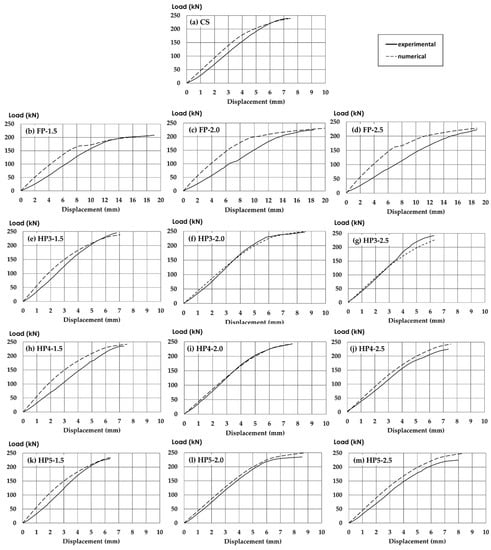
Figure 10.
Load-displacement curve comparison.
The numerical models for the FP series also showed higher initial stiffness when compared with the experimental results. This indicates that no delamination of the side concrete took place at the early stage of loading. A similar phenomenon was observed in Rahman’s [33] work, as the numerical models were unable to simulate fine hairline crack propagation as observed in the experimental specimens. Nonetheless, the majority of developed numerical models were able to simulate load versus mid-span displacement profiles that were similar to the experimental specimens.
Table 7 compares the numerical ultimate load with the experimental results for each specimen. Overall, the developed numerical models show ±10% of deviation in the ultimate load as compared with the experimental specimens. This shows a reasonable level of accuracy [5] which is important for any future parametric study and further optimization work on the proposed design configuration based on the developed model. Hence, the developed model has the potential for future evaluation on the performance of the proposed beam under cyclic loadings and fixed end support conditions. In addition, it can also be used to validate the outcomes of any new design formula developed in future for proposed deep beams.

Table 7.
Comparison of ultimate load between experimental specimens and numerical models.
Figure 11 illustrates the comparison of the cracking developed in the experimental and numerical work for each specimen. Figure 12 shows the three general types of numerical crack pattern superimposed on the experimental results. The numerical concrete tension damage view was selected in this comparison as it represents the tension cracks formed in concrete. It is observed that all the numerical models showed a good correlation in progressive and ultimate tension crack patterns with the experimental specimens.
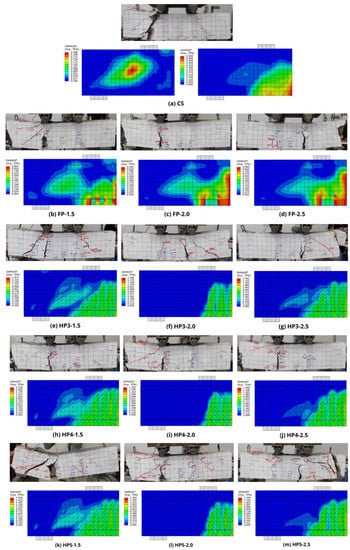
Figure 11.
Crack pattern comparison.
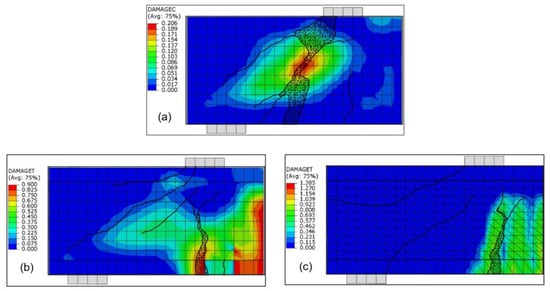
Figure 12.
Superimposition of experimental and numerical crack patterns of specimens. (a) Specimen CS; (b) FP series specimens; (c) HP series specimens.
5. Conclusions
In this study, experimental and numerical studies were conducted to investigate the strength of deep beams fitted with TMS plates to replace conventional shear links as shear reinforcement. The effects of two different types of detailing in the TMS plates were studied: (i) the perforated hole arrangement on the TMS plates and (ii) the TMS plate thickness. Thirteen deep beam specimens were fabricated, comprising one control specimen with conventional shear link as shear reinforcement (specimen CS), three specimens with TMS plates with no holes (FP series), and three specimens for each category of perforated TMS plates with three, four, and five columns of perforated holes (HP3, HP4, and HP5 series). All the specimens were experimentally tested with a four-point load test and numerically simulated. From the results, it is concluded that:
- The introduction of holes to the TMS plates produces a slight improvement in the load-carrying capacity compared with the control specimen and FP series specimens. This is because the perforated holes in the TMS plates allow the concrete matrix to pass through the inner core and sides of the concrete cover layers of the deep beam, which then promotes the formation of concrete tenons and better bonding of the perforated TMS plates to the concrete. However, the implementation of more than three columns of holes on the TMS plates decreases the load-carrying capacity in the deep beams, as the effective shear area in these TMS plates was reduced.
- Among the 1.5 mm, 2.0 mm, and 2.5 mm TMS plate thickness specimens, the specimens with 2.0 mm plate thickness can yield the highest load-carrying capacity and recorded the largest ultimate displacement across all the types of series, as the 2.0 mm thick plate provided adequate stiffness.
- The implementation of holes in the TMS plates on RC deep beams altered the failure mode that is commonly seen in conventional RC deep beams. The test results showed the development of gradual flexural cracks before the ultimate loading stage was reached, and diagonal tension cracks when approaching the ultimate loading stage. Compared with the FP series specimens, which showed sudden diagonal tension crack formation at the late stage of loading, the holes in the TMS plates from the HP series specimens showed a reduction in the progression rate of diagonal tension crack formation. This is attributed to the better bonding developed between the inner core and side concrete cover layers of the deep beam.
- All the developed numerical models were able to simulate progressive and ultimate tension crack patterns similar to those observed in the experimental tested specimens. Numerical load-displacement results for the thirteen specimens show a good correlation with the experimental results, with ±10% differences in the values recorded for each specimen. These numerical models can fulfill the needs of future optimization work on proposed deep beams without conducting expensive experimental work such as under the excitation of cyclic loading and fixed end support conditions.
Author Contributions
Conceptualization, K.F.C., K.S.W., J.H.L. and F.W.L.; methodology, K.F.C., K.S.W. and J.H.L.; validation, J.K.W., Y.L.L. and F.W.L.; formal analysis, K.F.C.; investigation, K.F.C.; resources, K.F.C., J.K.W., J.H.L. and Y.L.L.; data curation, K.F.C. and J.K.W.; writing—original draft preparation, K.F.C.; writing—review and editing, K.S.W. and Y.L.L.; visualization, K.F.C. and J.H.L.; supervision, K.S.W., J.H.L. and F.W.L.; project administration, K.S.W.; funding acquisition, K.S.W. All authors have read and agreed to the published version of the manuscript.
Funding
This research was funded by Universiti Tunku Abdul Rahman under the Universiti Tunku Abdul Rahman Research Fund (UTARRF) Project No. IPSR/RMC/UTARRF/2020-C1/W02. This support is gratefully acknowledged.
Institutional Review Board Statement
Not applicable.
Data Availability Statement
Not applicable.
Acknowledgments
We gratefully acknowledge the support from Universiti Tunku Abdul Rahman in using the laboratory facilities for the experimental and numerical works. We also like to thank Universiti Tenaga Nasional for its support in part of the numerical work and work verification.
Conflicts of Interest
The authors declare no conflict of interest.
References
- EN 1992-1-1:2004; Eurocode 2: Design of Concrete Structures—Part 1-1: General Rules and Rules for Buildings. British Standards Institution: London, UK, 2004.
- Li, R.; Deng, M.; Zhang, Y.; Wei, D. Shear Strengthening of Reinforced Concrete Deep Beams with Highly Ductile Fiber-Reinforced Concrete Jacket. J. Build. Eng. 2022, 48, 103957. [Google Scholar] [CrossRef]
- Tran, C.T.N.; Nguyen, X.H.; Le, A.T.; Nguyen, H.C.; Le, D.D. Shear tests of GFRP-reinforced concrete beams strengthened in shear by textile reinforced concrete. Structures 2021, 34, 4339–4349. [Google Scholar] [CrossRef]
- Tiwary, A.K.; Singh, S.; Kumar, R.; Sharma, K.; Chohan, J.S.; Sharma, S.; Singh, J.; Kumar, J.; Deifalla, A.F. Comparative Study on the Behavior of Reinforced Concrete Beam Retrofitted with CFRP Strengthening Techniques. Polymers 2022, 14, 4024. [Google Scholar] [CrossRef] [PubMed]
- Al-Gasham, T.S.; Mhalhal, J.M.; Abid, S.R. Flexural behavior of laced reinforced concrete moderately deep beams. Case Stud. Constr. Mater. 2020, 13, e00363. [Google Scholar] [CrossRef]
- Adhikary, B.B.; Mutsuyoshi, H. Shear Strengthening of RC Beams with Web-Bonded Continuous Steel Plates. Constr. Build. Mater. 2006, 20, 296–307. [Google Scholar] [CrossRef]
- Sudarsana, I.K.; Chandra Sajana, I.P.; Ngurah Oka Suputra, I.G. Applications of Bolted Steel Plates to Shear Strengthening of RC Beams. In Proceedings of the International Conference on Advances in Civil and Environmental Engineering, Bali, Indonesia, 24–25 October 2018. [Google Scholar]
- Arslan, G.; Sevuk, F.; Ekiz, I. Steel plate contribution to load-carrying capacity of retrofitted RC beams. Constr. Build. Mater. 2008, 22, 143–153. [Google Scholar] [CrossRef]
- Hou, W.; Lin, G.; Chen, B.; Guo, Z. Cyclic Behavior and Analysis of Steel Plate Reinforced Concrete Coupling Beams with a Span-to-Depth Ratio of 2.5. Soil Dyn. Earthq. Eng. 2021, 148, 106817. [Google Scholar] [CrossRef]
- Chen, C.-C.; Lin, K.-T.; Chen, Y.-J. Behavior and Shear Strength of Steel Shape Reinforced Concrete Deep Beams. Eng. Struct. 2018, 175, 425–435. [Google Scholar] [CrossRef]
- Deng, M.; Ma, F.; Wang, X.; Lü, H. Investigation on the Shear Behavior of Steel Reinforced NC/HDC Continuous Deep Beam. Structures 2020, 23, 20–25. [Google Scholar] [CrossRef]
- Wang, X.; Liu, Y.; Lu, Y.; Li, X. Shear Transfer Mechanism of Perforated Web Connection for Concrete Encased Steel Structures. Eng. Struct. 2022, 252, 113418. [Google Scholar] [CrossRef]
- Foster, S.J. Design of non-flexural members for shear. Cem. Concr. Compos. 1998, 20, 465–475. [Google Scholar] [CrossRef]
- BS EN 12390-3:2009; Testing Hardened Concrete—Part 3: Compressive Strength of Test Specimens. British Standards Institution: London, UK, 2009.
- BS EN 12390-6:2009; Testing Hardened Concrete—Part 6: Tensile Splitting Strength of Test Specimens. British Standards Institution: London, UK, 2009.
- ISO 6892-1:2009; Metallic Materials—Tensile Testing—Part 1: Method of Test at Room Temperature. International Organization for Standardization: Geneva, Switzerland, 2009.
- Wang, Z.; Wei, Y.; Li, N.; Zhao, K.; Ding, M. Flexural behavior of bamboo–concrete composite beams with perforated steel plate connections. J. Wood Sci. 2020, 66, 1–20. [Google Scholar] [CrossRef]
- Lee, Y.L.; Lim, J.H.; Lim, S.K.; Tan, C.S. Flexural behaviour of reinforced lightweight foamed mortar beams and slabs. KSCE J. Civ. Eng. 2018, 22, 2880–2889. [Google Scholar] [CrossRef]
- Lam, W.Y.; Su, R.K.L.; Pam, H.J. Strength and ductility of embedded steel composite coupling beams. Adv. Struct. Eng. 2003, 6, 23–35. [Google Scholar] [CrossRef]
- Subedi, N.K. Reinforced Concrete Beams with Plate Reinforcement For Shear. In Proceedings of the Institution of Civil Engineers Part 2, London, UK, 28–29 September 1989. [Google Scholar]
- Huang, B.-T.; Weng, K.-F.; Zhu, J.; Huang, B.-T.; Dai, J.-G.; Zhu, J.-X.; Shah, S.P.; Murphy Professor, W.P. Flexural Performance of UHPC-Concrete-ECC Composite Member Reinforced with Perforated Steel Plates. J. Struct. Eng. 2021, 147, 04021065. [Google Scholar] [CrossRef]
- Tian, J.; Shi, Q.; Li, S.; Tao, Y.; Guo, H. Experimental and numerical study of PRC coupling beams with low span-to-depth ratio. J. Constr. Steel Res. 2019, 159, 34–52. [Google Scholar] [CrossRef]
- Hadigheh, S.A.; McDougall, R.; Wiseman, C.; Reid, L. Evaluation of Composite Action in Cross Laminated Timber-Concrete Composite Beams with CFRP Reinforcing Bar and Plate Connectors Using Digital Image Correlation (DIC). Eng. Struct. 2021, 232, 111791. [Google Scholar] [CrossRef]
- Zhuang, B.; Liu, Y.; Yang, F. Experimental and numerical study on deformation performance of rubber-sleeved stud connector under cyclic load. Constr. Build. Mater. 2018, 192, 179–193. [Google Scholar] [CrossRef]
- Carreira, D.J.; Chu, K.H. Stress-strain relationship for plain concrete in compression. J. Proc. 1985, 82, 797–804. [Google Scholar]
- Lima, M.M.; Doh, J.H.; Hadi, M.N.; Miller, D. The effects of CFRP orientation on the strengthening of reinforced concrete structures. Struct. Des. Tall Spec. Build. 2016, 25, 759–784. [Google Scholar] [CrossRef]
- Wahalathantri, B.; Thambiratnam, D.; Chan, T.; Fawzia, S. A material model for flexural crack simulation in reinforced concrete elements using ABAQUS. In Proceedings of the first international conference on engineering, designing and developing the built environment for sustainable wellbeing, Queensland University of Technology, Brisbane City, Australia; 2011; pp. 260–264. [Google Scholar]
- Pauw, A. Static Modulus of Elasticity of Concrete as Affected by Density; University of Missouri: Columbia, MO, USA, 1960. [Google Scholar]
- Abdel-Nasser, A.G.; Sharaf, T.; Ghatass, H.; Abdel-Galil, E. Analysis of Reinforced Concrete Deep Beams Using Nonlinear Strain Model. Port-Said Eng. Res. J. 2017, 21, 231–240. [Google Scholar] [CrossRef]
- Jasim, W.A.; Tahnat, Y.B.A.; Halahla, A.M. Behavior of reinforced concrete deep beam with web openings strengthened with (CFRP) sheet. Structures 2020, 26, 785–800. [Google Scholar] [CrossRef]
- Kachlakev, D.I.; Miller, T.H.; Potisuk, T.; Yim, S.C.; Chansawat, K. Finite Element Modeling of Reinforced Concrete Structures Strengthened with FRP Laminates (No. FHWA-OR-RD-01-XX); Oregon Dept. of Transportation Research Group: Salem, OR, USA, 2001.
- Kotsovos, M.D. Finite-Element Modelling of Structural Concrete: Short-Term Static and Dynamic Loading Conditions; CRC Press: Boca Raton, FL, USA, 2015. [Google Scholar]
- Rahman, A.F.; Goh, W.I.; Mohamad, N.; Kamarudin, M.S.; Jhatial, A.A. Numerical analysis and experimental validation of reinforced foamed concrete beam containing partial cement replacement. Case Stud. Constr. Mater. 2019, 11, e00297. [Google Scholar] [CrossRef]
Disclaimer/Publisher’s Note: The statements, opinions and data contained in all publications are solely those of the individual author(s) and contributor(s) and not of MDPI and/or the editor(s). MDPI and/or the editor(s) disclaim responsibility for any injury to people or property resulting from any ideas, methods, instructions or products referred to in the content. |
© 2023 by the authors. Licensee MDPI, Basel, Switzerland. This article is an open access article distributed under the terms and conditions of the Creative Commons Attribution (CC BY) license (https://creativecommons.org/licenses/by/4.0/).